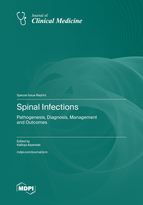Spinal Infections: Pathogenesis, Diagnosis, Management and Outcomes
A special issue of Journal of Clinical Medicine (ISSN 2077-0383). This special issue belongs to the section "Orthopedics".
Deadline for manuscript submissions: closed (30 November 2023) | Viewed by 14377
Special Issue Editor
Interests: spinal surgery; trauma; biomaterials
Special Issues, Collections and Topics in MDPI journals
Special Issue Information
Dear Colleagues,
Τhe field of spinal infections constitutes a demanding diagnostic and management problem for which multidisciplinary approach with spine surgeons, radiologists, and infectious disease specialists is required. Patients expect not only pain alleviation but also rapid recovery of function. Spinal infections can be classified by the anatomical location involved: the vertebral body, the intervertebral disc space, and the spinal canal. Infections are usually caused by bacteria although fungal infections may also occur. Spinal infections can be primary typically through hematogenous spread of the microorganism from a distant infected area or can occur after surgery. Adults are affected far more often, while the incidence of spinal infection in patients less than 20 years old in developed countries is 0.3/100,000.
The current standard of care involves aggressive, prolonged antibiotic administration with or without surgical debridement of the infected tissues. Although traditional treatment may be sufficient for managing a portion of cases, recurrences of the infection and associated risks including pain, spinal instability, neurological impairment, and toxicity with long‐term antibiotic usage have been reported.
Among the pertinent practical open questions in the field of spinal infections are the benefits of spinal instrumentation, the role of emerging technologies in diagnosis and treatment, such as minimal invasive surgery, the design of novel implants and smart materials, and the optimization of antibiotic treatment.
The aim of this Special Issue, therefore, is to provide a stage for outstanding clinical, technical, and epidemiological contributions describing recent advances that can lead to improvements of diagnosis, treatment, and prognosis in the field of spinal infections.
Dr. Kalliopi Alpantaki
Guest Editor
Manuscript Submission Information
Manuscripts should be submitted online at www.mdpi.com by registering and logging in to this website. Once you are registered, click here to go to the submission form. Manuscripts can be submitted until the deadline. All submissions that pass pre-check are peer-reviewed. Accepted papers will be published continuously in the journal (as soon as accepted) and will be listed together on the special issue website. Research articles, review articles as well as short communications are invited. For planned papers, a title and short abstract (about 100 words) can be sent to the Editorial Office for announcement on this website.
Submitted manuscripts should not have been published previously, nor be under consideration for publication elsewhere (except conference proceedings papers). All manuscripts are thoroughly refereed through a single-blind peer-review process. A guide for authors and other relevant information for submission of manuscripts is available on the Instructions for Authors page. Journal of Clinical Medicine is an international peer-reviewed open access semimonthly journal published by MDPI.
Please visit the Instructions for Authors page before submitting a manuscript. The Article Processing Charge (APC) for publication in this open access journal is 2600 CHF (Swiss Francs). Submitted papers should be well formatted and use good English. Authors may use MDPI's English editing service prior to publication or during author revisions.
Keywords
- spinal infection
- bacteria spine
- spondylodiscitis
- vertebral infection
- lumbar infection
- thoracic infection
- sacral infection
- cervical infection
- disc infection







